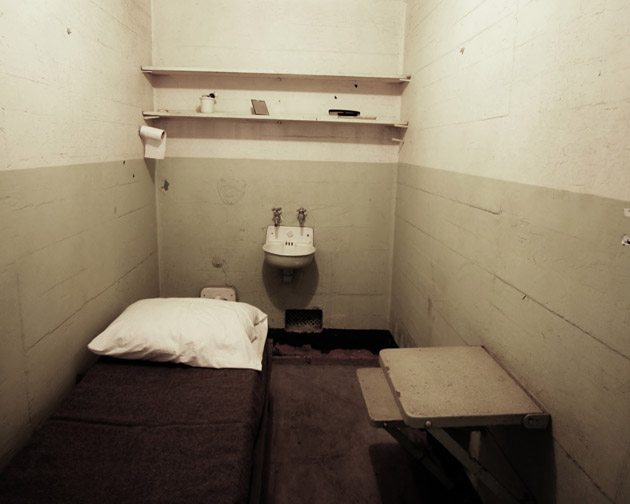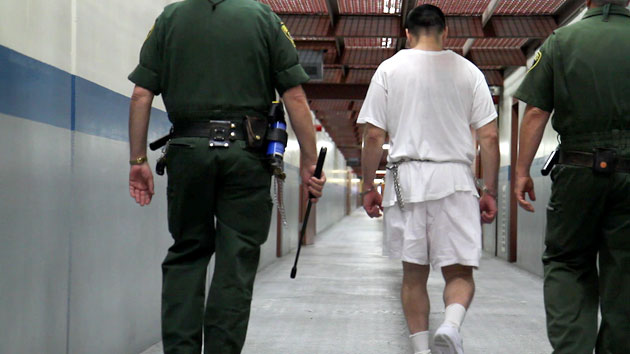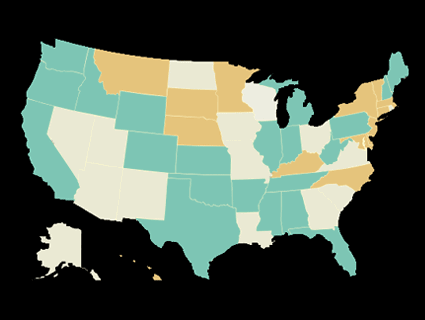
<a href="http://www.shutterstock.com/pic.mhtml?id=1594675">Dan Lee</a>/Shutterstock
The U.S. Bureau of Prisons currently holds more than 12,400 individuals in 23-hour-a-day lockdown, making it the largest practitioner of solitary and other forms of isolated confinement in the nation, and most likely the world. Yet the BOP does not know whether its use of “segregated housing” has any impact on prison safety, how it affects the prisoners who endure it, or how much it all costs American taxpayers. This according to a comprehensive new report from the Government Accountability Office.
The GAO documents a dramatic rise in the use of isolated confinement in federal prisons over the past five years. Yet the “BOP has not assessed the impact of segregated housing on institutional safety or the impacts of long-term segregation on inmates,” the report states.
The report was put together at the request of three members of Congress: Senator Dick Durbin (D-IL), who last year convened a Judiciary Subcommittee hearing on solitary confinement in which he sharply questioned BOP director Charles Samuels; Elijah Cummings (D-MD), ranking member on the House Committee on Oversight and Government Reform; and Bobby Scott (D-VA), ranking member on the House Judiciary Subcommittee on Crime, Terrorism, Homeland Security, and Investigations. Their letter states:
There is little publicly available information on BOP’s use of segregated housing units. Given the potential high costs, lack of research on their effectiveness, and possible long-term detrimental effects on inmates, you requested that we review BOP’s segregated housing unit practices, including BOP’s standards, reasons for segregating inmates, and costs.
The report is a trove of information on a subject that has been largely hidden from the public by the BOP, which bars press visits to its solitary confinement facilities, and which collects and publishes little data on its use of isolation.
The GAO begins by outlining the nuances around what is colloquially known as “the hole.” Individuals can be placed in Special Housing Units (SHUs) in either “administrative detention” (for classification or security reasons) or “disciplinary segregation” (for breaking prison rules). They are supposed to be there for finite terms. (That is often not the case, as we reported in our special package on solitary confinement.) Those in Special Management Units (SMUs) are most often classified as members of a gang or other “disruptive group” or have “a history of serious disruptive disciplinary infractions.” The prisoners held at the Administrative Maximum (ADX) facility in Florence, Colorado, are supposed to be “inmates whose placement in another facility poses a risk to inmates, staff, or the public or good order of the facility; and/or inmates whose status before or after incarceration does not allow them to be safely housed in another facility.”
In all three types of isolated confinement, individuals remains in their cells for at least 23 hours a day, eat in their cells, have minimal exercise and programming and limited visits and phone calls. Those in the SHUs or SMUs may be double-celled; those at ADX are always alone. (The BOP’s two Communications Management Units, or CMUs, are included only as an appendix, the report states, because individuals imprisoned there have some out-of-cell time.) Prisoners are placed in isolated confinement through various types of hearing processes that rely solely on prison officials to provide evidence and make judgments, and are kept there according to review proceedings that are often appear somewhat or entirely pro forma. (This is also the case in state prisons.)
The GAO report breaks down the numbers for us: About 7 percent of all federal inmates in BOP facilities are held in segregation. As of February, 81 percent (10,050) of those segregated prisoners were held in SHUs and 16 percent (1,960) in SMUs—450 were holed up at ADX. “From fiscal year 2008 through February 2013, the total inmate population in segregated housing units increased approximately 17 percent—from 10,659 to 12,460 inmates,” it notes. “By comparison, the total inmate population in BOP facilities increased by about 6 percent since fiscal year 2008.”
In a section of the report on how the BOP monitors its segregation practices, the GAO finds particular fault with the bureau’s procedures at ADX, and with the dearth of documentation in all areas at nearly all BOP facilities. The GAO also looks at how the BOP tracks—or fails to track—the additional costs of housing people in isolated confinement: “BOP computes costs by facility or complex, and does not separate or differentiate the costs for segregated housing units, such as SHUs, SMUs, and ADX that may be within the complex.”
However, for the first time—apparently in response to requests from the GAO—federal prison officials calculated a “snapshot estimate” of per-inmate costs at sample facilities as of January 31: Housing a typical prisoner at the federal prison complex in Florence cost an estimated $86 a day, while keeping a prisoner at ADX cost $216 a day. The cost per inmate at a sample SMU facility was about $120, far higher than the $69 per diem for a general-population prisoner at a high-security facility.
So, by the BOPs numbers, keeping a person at ADX costs more than $78,000 a year, three times the tab to house someone at a standard high-security facility. The overall cost of keeping federal prisoners in isolated confinement runs well into the tens of millions of dollars per year.
Perhaps the most damning bit comes near the end of the report, where the GAO points out that the bureau has no evidence to prove that all this spending makes its prisons safer. “BOP senior management and prison officials told us that they believed segregated housing units were effective in helping to maintain institutional safety.” But this belief, the report points out, runs in the face of evidence from states that have reduced their use of isolated confinement: “Officials from all five states we spoke with reported little or no adverse impact on institutional safety.”
Finally, the BOP also has no real idea of what its grand experiment in isolation may be doing to the people in its care: “BOP’s Office of Research and Evaluation (ORE) officials said they have not studied the impact of long-term segregation on inmates because of competing priorities,” the report notes. It goes on:
While most BOP officials told us there was little or no clear evidence of mental health impacts from long-term segregation, BOP’s Psychology Services Manual explicitly acknowledges the potential mental health risks of inmates placed in long-term segregation. Specifically, it states that BOP “recognizes that extended periods of confinement in Administrative Detention or Disciplinary Segregation Status may have an adverse effect on the overall mental status of some individuals.” In addition, according to BOP’s mission statement, BOP protects society by confining offenders in prisons that are, among other things, safe and humane.
The GAO adds an understated, but subtly damning statement about the BOP’s lack of accountability, and recommends that the BOP improve its documentation and monitoring of segregated housing, especially at ADX, and take actions to fill the gaps in its knowledge about the impacts of solitary on prison safety and the mental health in its prisoners.
According to the report, the BOP concurs with and has promised to take action on its recommendations. This surely will not happen quickly. Whether it happens effectively, in a way that genuinely changes the day-to-day reality of the 12,400 federal prisoners living in isolation, remains to be seen.
A version of this story first appeared on SolitaryWatch.















